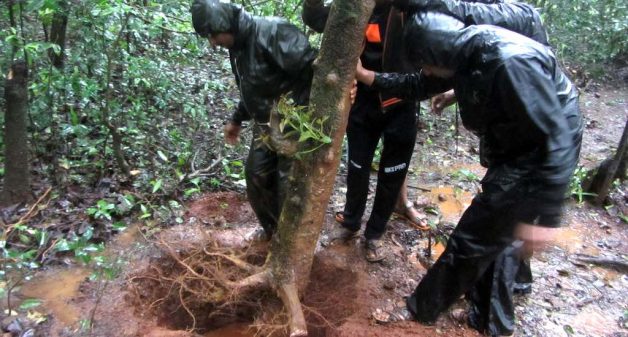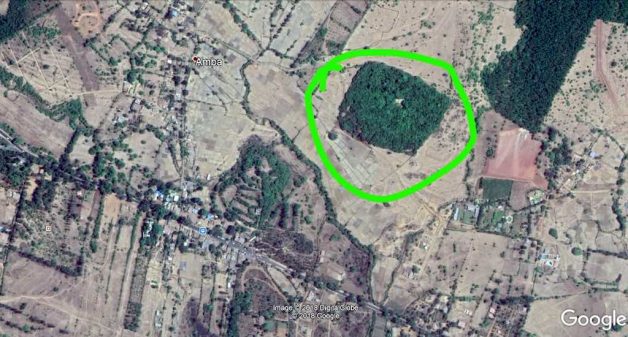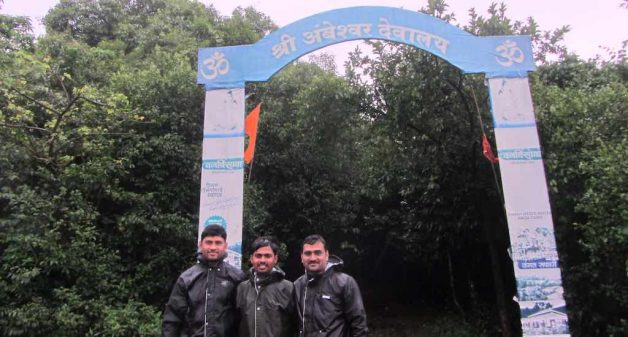
Village youth in Western Ghats enrich sacred grove
A bunch of passionate young men are saving big trees uprooted in the Sahyadri Mountains by transplanting them at their village’s sacred grove. And that’s just one part of their conservation work

A bunch of passionate young men are saving big trees uprooted in the Sahyadri Mountains by transplanting them at their village’s sacred grove. And that’s just one part of their conservation work
It is four in the evening. It has been raining relentlessly and everything around is drenched. The black tar road is washed clean as it marks a serpentine route through the lush green surroundings. The fog adds a layer of mystery to the environment that is slowly getting darker.
This is a village perched atop 2,400 feet in the Sahyadri Mountains, the local name for one of the UNESCO decorated biodiversity hotspot Western Ghats. This is mid-July, which along with August receives the high rainfall. And it is indeed a high rainfall quantum — mean annual rainfall of 4,500 mm, ranging between 3,000 mm to 6,000 mm depending upon the altitude — that nourishes the rich biodiversity of the region.
A bunch of youths are on a mission in the pouring rains. Four of them have found a tree uprooted after a wall fell due to excessive rain over the past two days. One of them get a tempo van and the others lift the heavy, more than six feet long trunk of Nana tree (Lagerstroemia Microcarpa, a flowering tree endemic to India, native to Western Ghats). Villagers have already taken away branches and leaves.
The small truck reaches the perimeter of a sacred grove, devraai in Marathi. Named after the local deity Ambeshwar (its temple is in the center of the sacred grove), this Ambeshwar Devraai is a wonderful patch of thick forest bang in the middle of a sloping mountain plateau. Surrounded by farmland, the grove stands out with its wide variety of evergreen trees, shrubs, climbers, creepers and a diverse collection of moss and lichen.
Replanting effort
Battling rain, the youth bring the tree to a designated spot where one of their colleagues has already dug a pit. As others struggle to hold the trunk straight into the pit, one of them deepens the pit further and other chops off some of the extra protruding roots. Finally, the wet trunk snugly fits into the pit and is covered with damp earth.
Even when drenched themselves, the youth, with a look of satisfaction at a job done well, pat the tree trunk and one of them, their leader Pramod Mali, says with a chuckle: “Please, do live.”
For almost five years now, this has become a weekly routine of sorts for the young men. On the lookout for any uprooted trees due to heavy rains in the mountains and on the highway, they quickly bring it to the sacred grove to transplant it. Mali and nine other youths from the village have formed a Vanrakshak Social Force that have been carrying out this transplantation exercise and other conservation work for the sacred grove and the surrounding forests.
“We have transplanted about 350 such trees in last five-six years. The nearest we brought was from about 1 km and the farthest is from the radius of 6 km. We brought one from almost 18 km away last year. The survival rate of these trees is 80%,” Mali told VillageSquare.in, as he and others proudly show other trees that they had replanted in the sacred grove in earlier years.

On the southern side of the sacred grove is a huge arch painted with the name of the deity. A bright shiny board besides it details the importance of the place with pictures of almost all elements of the biodiversity found there. As the group enters enter the brown stony upward path shining after cleansed fresh with water and dotted with greens here and there, it indeed feels as if they were are entering a cloudy abode of the deity.
Functional parts
The youth have divided the devraai in four parts. Three are already named and functional. Punarjanm Mohim (Transplantation Mission) is where they bring uprooted trees and replant them. Mangal Van is where people plant trees on the day when their near and dear ones get married. They inform the newly married couple about it and urge them to plant trees too. Fulora Van is where people plant native trees on their birthdays or that of near and dear ones. The fourth is a proposed Smruti Van, a place where people can plant trees in remembrance of their family members or friends.
“We get these plants from a nursery. And we have been getting good response to this. At times, even some visitors have evinced interest in this,” Avinash Ghadge, 31, told VillageSquare.in.
The team has already started documentation of the rich biodiversity of the sacred grove. There are 86 trees, nine climbers, and 27 shrubs, apart from scores of herbs, algae, fungus and creepers. There are 18 species of birds and 23 species butterflies, not to mention the large number of insects and reptiles.
This area has mixed semi evergreen and moist mixed deciduous forests as part of the Western Ghats. The Working Plan for the Forests of Kolhapur Forest Division says that the sacred grove is spread over 4.25 Ha. The neighboring reserved forest is 318.16 Ha.
Biodiversity riches
Amba village is immediately to the east of Amba Ghat (pass) on the state highway that connects Kolhapur in western Maharashtra to Ratnagiri in the Konkan region. Till a few years ago, it was surrounded by little agriculture land and dense forest. As per the Census 2011, there are 256 households in the village that has a population of 1195. Many villagers have chosen to migrate to cities, and the remaining farm the land.
Amba falls in the buffer area of two parts of the Sahyadri Tiger Reserve (one each on the north and south side of it). The surrounding jungle, nearby places of historic importance such as Vishalgadh Fort, Pavan Khind and scores of waterfalls and dam reservoirs have turned Amba village into a base camp for tourists.
Tourist influx
In 2018, the forest is patchy, as the village has undergone a sea change with a multitude of resorts dotting the landscape — from just two about a decade ago to 36 as on date. Although tourists are bringing in much-needed earnings, they are also a cause of worry for these young conservationists.
With his colleagues, Mali, 32, runs the Vasundhara Eco Tours for sustenance, taking tourists on jungle treks. They teach people how to observe the forest, how to read each movement, from termites to timber, from algae to aves, everything is part of the jungle and have a role in the food chain. There are one-day, two-day treks almost round the year but less in peak monsoon as the jungle is infested with leaches.
Forest conservation
But it is not just uprooted tree transplantation that these youth carry out. They are into varied forest conservation and preservation activities. So, how did Mali and his team form the Vanrakshak Social Force two years ago? The increasing number of tourists and mainly their unwarranted activities got them worried. Jungle trips by outsiders for drinking sessions, loud music, broken liquor bottles troubled the youth.
“What if a Gaur gets hurt because of such a bottle?” “What happens to the greenery in case of forest fire due to leftover garbage by tourists?” The youth started asking these questions. The rich biodiversity is just too fragile and precious to be lost to such reasons.

On this rainy day, Mali and Ghadge are accompanied by Nikhil Kolte, 29, and Dinesh Kambli, 32, both drivers, and Dipak Patel, 27, an employee of a local pharmacy. “I was always interested in nature and wildlife since my school days. I was impressed by what this team was doing. So, I joined them about three years ago,” Kambli said.
Kambli, Patel and Ghadge have all been carrying out work on water holes deep inside the jungle. Each year on April 27, 28 and 29, the team works on conservation of water holes, all with local resources. “There is lot of man-animal conflict. Peacocks, monkeys, langurs, wild boars, sambhar and barking deer, all reach the villages in summers when there is less water in the jungles. Erecting a fence with electric current is too dangerous for men and animal both. So, conservation of and building new water holes is the best solution,” Ghadge told VillageSquare.in.
The team also carries out night searches, chasing smugglers and poachers. Once in a month, they carry out a cleaning campaign at all the nearby tourist spots. There are 13 destinations within a 20 km radius of the village, where the team goes and works for keeping the places clean.
Future hope
There are few volunteers from outside too who have been actively supporting Mali and his team. Former teacher Chitkala Kulkarni, who hails from Ichalkaranji, about 100 km from here, has been coming to the village for a few years. Three years ago, she met Mali. “For the first time, I hired him as a guide and trekked a lot in the jungles. Then it became a routine whenever I came to Amba, I would always go on a jungle trek with him,” Kulkarni, a nature lover, said.
Last year in May, on a jungle trek with Mali, she and her college-going daughter encountered a forest fire. Mali immediately took on himself to use tree branches to put off the fire. He dug trenches to cut off the fire from spreading to more areas. Few days later, again on another trek, they were crossing an almost dry brook. Possibly some leftovers by rowdy bunch of visitors prior to them was enough to catch fire, which was spreading slowly. The fallen leaves from the thick jungle act as natural compost for the terrain and increase its bio-diversity. “Sensing this, Mali began to put off the fire immediately to not let the entire natural compost burn. We too helped him. That was when I realized his deep understanding of the jungle,” Kulkarni told VillageSquare.in.
Now, she is a regular volunteer in almost all the team’s works but mainly she has started helping the youths in documentation.
But more important are the villagers. Harvinder Saini, a mason from Sikar in Rajasthan, and now settled for work in Amba, says, “For last six years I have been here, I have seen there is too much politics in the village that is proving detrimental to progress. But now, with the work these youngsters are carrying out, I see slowly but surely increasing awareness, I see hope.”
After Mali and his team’s sustained work for last three-four years, the villagers are finally waking up to the problem and possible solutions. Leading from the front is Sakshi Diwakar Bhingarde, the village chief.
In her mid-30s, Bhingarde remembers the dense forest that surrounded her village when she was a school-going child and rues the fact that so much of forest degradation has occurred over past 10 years or so. She attributes the damage mostly to the fact that as agriculture became unsustainable, more and more villagers sold their lands. This has led to the proliferation of resorts and loss of forest.
The sacred grove, as she recalls, was once such a thick forest that not just children but even the adults would not venture there alone during the day. Sighting of Gaur was a common thing. Owl has gone missing since last two decades, she says.
When it came to the sacred grove, the villagers followed an unwritten rule as a tradition for centuries. No felling of trees was allowed. Even the naturally uprooted trees, dry firewood or the brown leaves would be left untouched. But now as people are taking it away, there is no compost, so almost no regeneration of forest.
“We will now be taking up measures to pass a resolution at our gram panchayat to ban any kind of tree felling and also no lifting of dry firewood or brown leaves from the sacred grove,” said Bhingarde.
Nivedita Khandekar is a Delhi-based journalist. Views are personal.